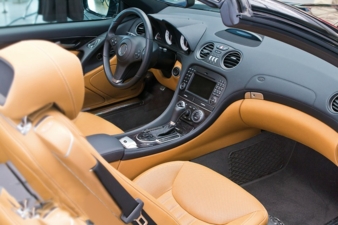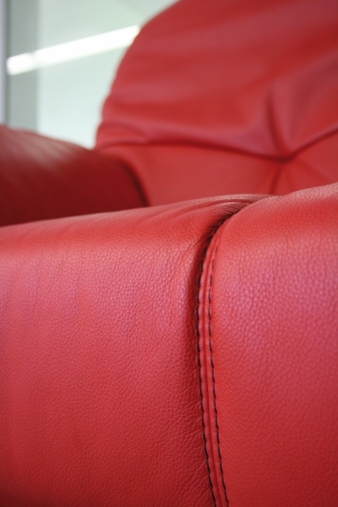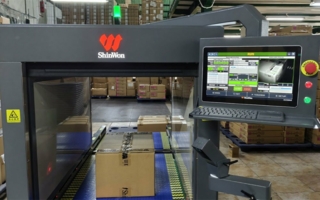26/01/2015 — auf Deutsch lesen
Perfect leather stitching
Ever since mankinds early days, animal hides have been processed into leather. Originally leather was used as clothing and in living areas, providing protection from cold and other external influences. Nowadays, the majority of the leather manufactured around the world is used in shoe production; but this hardwearing material also has its uses in the automobile and furniture industries.
Animal hides form the raw material for leather production. Cattle, calves, sheep, goats and pigs provide 95% of them but reptiles and fish are also used as a source for certain fashion products. Whereas in the Stone Age the hides were dried or smoked to make them durable, in the 19th century there was a switch to tanning with chromium salts. This tanning process shortened the production time, provided softer and more easily worked leather and thus encouraged systematic mineral tanning. Today, tanning with chromium salts, along with processes using fats and oils, continues to be central to the industry.
Leather is made from the dermis of the animal, which in turn consists of the papillary (or grain) layer that gives the leather its shiny surface and the thicker reticular layer beneath, which provides its physical strength. Other properties of the leather are affected by the tanning process so that, for instance, it can be made into a highly wear-resistant leather for the soles of shoes or a resilient and pliant leather for the uppers. The leather is coloured after tanning and this may be followed by surface treatment to give the leather a specific appearance such as a matte or glossy finish, or to improve its resistant qualities.
Since leather is a natural product, its specific properties need to be taken into account during the processing. It will have a direction of grain related to the position of the animals ribs, and it will tear or stretch more easily in that direction. Leather made for tear-resistant products, therefore, will be worked against the direction of the grain. Moreover, all of the individual pieces must be cut in the same direction in relation to the grain, even if this means more material has to be used.
When stitching leather, a number of factors must be taken into account. The durability of the seam – that is, the seam strength – is usually the most important aspect. The stitch density has a major influence on this: the higher the stitch density (i.e. the greater the number of stitches per centimetre), the more thread there will be in the seam. This increases the tear-resistance of the seam as far as the thread is concerned.
The tear-resistance of the leather itself, however, also contributes to the strength of the seam – the larger the hole made by the needle in the leather, the less durable it will be. For this reason, the thickness of the needle needs to be selected such that the needle itself is sufficiently sturdy for the stitching process and the thread can pass unobstructed through the eye of the needle. At the same time, though, unnecessarily large holes are to be avoided so the needle should be no thicker than is necessary. The general principle is that maximum seam strength is reached when, if the seam is torn apart in a transverse direction, both the leather and the stitching will break. This represents the intersection between thread-related seam strength and the resistance of the leather, which depends on the cutting tips used.
The seams appearance also plays an important role when stitching leather. Particularly in the automotive field but also for high-value clothing and accessories, great importance is placed on having a visually perfect seam. One factor that is responsible for the appearance of the seam is the way the structure of the leather varies with and across the grain: because of the hair canals and sweat glands, which run only in a longitudinal direction, the seam will look different depending on its course.
The biggest influence on the seams appearance, however, is the type of needle tip. The hole pierced in the leather will have a different shape depending on the geometry and orientation of the cutting tip. This produces different seam shapes, from straight to curved. The stitch length and the entry point of the thread into the leather are also determined by the tip. Depending on the texture of the leather, the cutting tip may be selected from the following types.
The choice of tip shape, however, will also depend on the design of the seam and the composition and condition of the leather (such as whether it is hard or soft). For closing and stay seams in relatively soft leather such as for car seats, needles with a limited cutting effect such as SD or R tips are the most suitable. Needles with a greater cutting effect should be avoided in such cases, since the cut holes can stretch if the seam is put under stress. For closing and stay seams on shoes (also known as heel stitching), where harder leathers are used, needles with P tips are more suitable, since the stitch holes will tend to close under stress and the seam is of fairly high strength.
In the case of quilting seams, the choice of tip shape depends largely on the required seam pattern. For decorative effects the LR tip is the most suitable, both for soft and for hard leather. If marked decorative effects with overlying seams are required on hard leather (on a belt, for example), the P tip should be used. For extensive straight quilting seams it is possible to use an S or an LL tip. For very hard and dry leather, and also for packaging, the D tip is the best choice. For multidirectional sewing machines, needles with an SD or R tip are preferable because the seam pattern stays the same in all directions. Cutting needles with a defined cutting direction are not suitable for sewing and embroidery machines as the seam pattern will change according to direction.
In the production of high value leather goods, 2-needle decorative seams frequently come into play. Here, for decorative purposes, two adjacent seams are formed in one operation. Ideally, the left and the right seam should both have the same pattern. Nevertheless, differences in the appearance of the two seams can arise due to varying thread direction and loop take-up between the left and right needle. To prevent this, Groz-Beckert has developed the SAN 12 special application needle which, through precise alignment of the cutting geometry, creates an even and harmonious seam pattern.
Leather will continue to be a constant feature in many areas in the future. Whether it is in clothing and the fields of protective, professional or functional garments, as accessories such as handbags, purses and gloves, for sport as the outer layer of balls or sports appliances, or as an indispensable material for the furniture and automotive industries – with such a wide range of properties, leather will always have its uses.





